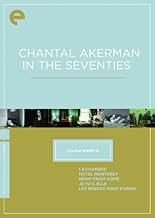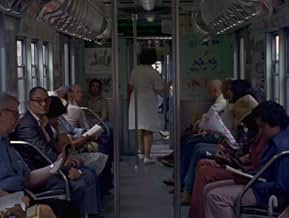Imagens impessoais, mas bonitas, da vida de Akerman em Nova York, combinadas com cartas de sua amorosa mas manipuladora mãe, lidas pela própria Akerman.Imagens impessoais, mas bonitas, da vida de Akerman em Nova York, combinadas com cartas de sua amorosa mas manipuladora mãe, lidas pela própria Akerman.Imagens impessoais, mas bonitas, da vida de Akerman em Nova York, combinadas com cartas de sua amorosa mas manipuladora mãe, lidas pela própria Akerman.
- Direção
- Roteirista
- Artista
- Self - Letter Reader
- (narração)
Avaliações em destaque
"News From Home" gives you that chance. It isn't a movie for the average viewer, or even the average museum goer. It's introspective, spellbinding and gorgeous, given a chance. I loaned it to a friend and suggested he "let yourself go" while watching it, and he reported "it turned into magic once I let it flow through me."
If you want things that blow up, swear words, and sex, you are in the way wrong place sister. This is one of the best art films I have ever seen, without all that inaccesible interiority of so many other "art" film makers.
It's more like a personal documentary, which sounds impossible to pull off doesn't it? Well, Derek Jarman's "Blue" pales to this private gallery of scenery and emotion, which makes "News" far advanced, cuz "Blue" is my fave of his.
Chantal's camera records all this squalor in exquisite, non-judgmental long takes. You can almost smell the place. Somehow, the city arranges itself for her in fascinating compositions of color, personalities, and activities. What's that guy over there doing? What is that woman thinking about?
In counterpoint to the visuals, Chantal reads irritating letters from her beloved mother complaining that Chantel does not write frequently enough and When is she coming home? But how could she come home when there is such rich, baroque subject matter for her camera? We know that after her mother died several years later, Chantal committed suicide. The tension between her mother's letters and the power of the city is palpable.
Chantal has left us this gift of a precise record of a time and place that existed once and will not exist again. The final extremely long shot, taken evidently from the Staten Island ferry, is of Manhattan with its Twin Towers still present slowly receding and disappearing in the mist.
It's a far piece from the world of Kenyon & Mitchell, but Akerman is not filming events where the attendees might hope to see themselves in a theater. I watched this movie and tried to figure out where each shot was taken. I think I was pretty successful. That game, however, did not take up the whole of the 85 minutes of the movie, and what was someone who was not an adult in Manhattan in the 1970s supposed to do? After ten or fifteen minutes, I decided that the audience was supposed to make of this a portrait of the recipient of the letter, an individual whose mother thinks she is hungry for news of the family, who never writes about whether she is happy or has made any friends (inference: she isn't and hasn't), and the shots are of her world in New York: first downtown near the River, then a long sojourn in the Times Square Subway Station and finally a ten-minute shot from the stern of the Staten Island Ferry setting out of Manhattan.
I think that with this movie, Akerman is trying to rewrite the relationship between film maker and audience. A film maker makes a film that tells a story, and the audience is the perceptive receiver of that tale, whether it is fiction or fact. We infer plot from the course of actions, from the changes in the personality, status, and relationships of the characters. We derive character from the way in which individual performers differ from the stereotyped roles. What, however, are we to make when you don't see the performer, don't hear her voice, except as a hurried reader of letters?
Well, the stereotypical responses fall neatly into two types. The first type says "Dagnabit! I came here to see a movie with interesting characters and a story! This is awful!" The second says "Ahah, this is new and interesting technique. I get what the auteur is trying to do, and approve, because that makes me a smarter, more percipient viewer." Which are you?
As for me, my reaction is "Interesting technique, but I'd prefer a little more effort from the film maker than forcing me to either fall asleep or make up my own story out of rags and tags." That's because I don't insist on a purely conventional story, but rather than being such an intelligent viewer that I get exactly what Akerman is trying to do, I'd like to have some character.
Você sabia?
- CuriosidadesWhen Akerman's mother writes her father lost 300,000 francs due to a client's bankruptcy, that would equate to about $8,300 at the time or $38,100 in 2019.
- Citações
Herself - Letter Reader: I received your screenplay. It's well-written, but you know my taste: I find it sad and gloomy. Those people sure have a hard life. It's an important social issue. I hope it will turn out well. The public must be made aware of all this suffering that you young people see so clearly.
- ConexõesFeatured in What to Watch: Cate Blanchett's Films of Hope (2020)
Principais escolhas
- How long is News from Home?Fornecido pela Alexa
Detalhes
- Data de lançamento
- Países de origem
- Idioma
- Também conhecido como
- News from Home
- Locações de filme
- Veselka Restaurant, 144 2nd Ave, Nova Iorque, Nova Iorque, EUA(newstand outside with awning in Ukrainian)
- Empresas de produção
- Consulte mais créditos da empresa na IMDbPro
- Tempo de duração
- 1 h 29 min(89 min)
- Mixagem de som
- Proporção
- 1.37 : 1






















